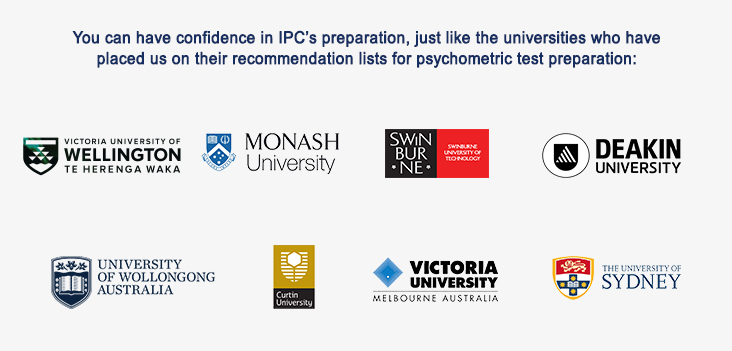Preparation for NSW Ambulance tests - cognitive and personality tests
NSW Ambulance psychometric tests – Preparation 2025
If you are applying to join NSW Ambulance, you will be required to take an interview and complete several challenging psychometric tests:
A timed abstract reasoning test.
A personality test measuring your atitutde.
What is NSW Ambulance's Abstract test?
NSW Ambulance's abstract test measures your conceptual reasoning skills. This test uses a unique style of abstract test questions to assess your conceptual reasoning and problem solving skills.
Please note: this abstract reasoning test is timed. The timer is set for each test question. You are given 90 seconds to complete each abstract test question.
NSW Ambulance's abstract reasoning test questions style
Each abstract test question incudes a list of original and final figures and a specific list of buttons that represent functions that convert the original figures into the final figures. Each button represents one function. In this style of abstract test questions, your task is to find what each specific button does in order to find how a specific original shape or shapes will change into the final figure. There are some examples of original and final figures and buttons displayed in a base scree, which you have to use to find what each button does. Once you find what the buttons do your then can find what the correct final figure is in the question line.
Let's examine the following NSW Ambulance abstract test question example:

In this abstract aptitude test question you need to find what buttons 1, 3 and 5 do.
From the first line, we see that the original figure (the three shapes to the left) goes through two transformations to form the figure on the right: (i) a change in the shapes (square to circle, or circle to square); and (ii) a change in colours (black to white, or vice versa). Two buttons are active in this line (1 and 2); however, we still don’t know which one changes the shape, or which one changes the colour.
The second line also shows a figure that swaps the colour of its three shapes, but there is no change in those shapes. This time, buttons 2, 3 and 4 are ‘active’ – so, button 2 (the only common ‘active’ button with line 1) must be the one that swaps colours; and we can now deduce that it is button 1 that changes (or toggles) the shapes. Buttons 3 and 4 must, then, be the ones that modify the horizontal and vertical lines, so we will need to refer to the third line to work out their individual functions.
In line three, because buttons 1 and 2 are ‘inactive’, we know that there will be no transformation of colour or shape. Buttons 4 and 5 are ‘active’, and we can see that the right figure has been made smaller and a vertical line removed. Line 3 shares only one active button with line 2 (i.e. button 4), and there is only one common transformation between these lines: the vertical line has been switched ‘on’ or ‘off’. Therefore, button 4 is a vertical line toggle switch, which means (from the previous line) that button 3 must be the on/off toggle for horizontal lines. Button 5, therefore, can only be for changing (or toggling) the size of the shapes in the figure (from big to small, or vice versa).
We can now summarise the button functions thus:
- Button 1 – toggles the shapes within the figure (squares to circles, and vice versa)
- Button 3 – toggles the horizontal lines on or off
- Button 5 – toggles the size (big or small) of the shapes within the figure.
Now, we can apply those button functions to our question line:
- Button 1 – will change the figure to a circle and a square.
- Button 3 – will add a horizontal line to all shapes in the figure.
- Button 5 – will toggle the shape sizes – the first from big to small, and the second from small to big.
The correct answer is:

What is NSW Ambulance's personalityt test?
NSW Ambulance Service uses a personality test that analyses 22 different personality scales about you to come up with your profile and identify areas of risk that will prevent you from becoming a member of Queensland Ambulance Service . For example, if you are someone who does not have a strong emotional resilience or you lie taking risks you will be taken out of the recruitment process.
The personality test includes 344 test questions which are not timed and each questions includes a statement and you are asked to state to what extend you believe each statement is true (from strongly disagree to strongly agree). The 22 scales measure:
- Clinical scales provide critical diagnostic features of 11 important clinical constructs. These 11 scales may be divided into three broad classes of disorders: those within the neurotic spectrum, those within the psychotic spectrum, and those associated with behavior disorder or impulse control problems.
- additional five scales include two indicators of potential for harm to self or others, two measures of your environmental circumstances, and one indicator of your motivation for treatment.
- Interpersonal scales provide information regarding your relationships and interactions. Interpersonal style is assessed along two dimensions: a warmly affiliative versus a cold rejecting style, and a dominating/controlling versus a meekly submissive style.
- Two scales assess pathology. The Borderline Features scale is the only scale that has four subscales, reflecting the factorial complexity of the construct. The Antisocial Features scale includes three subscales: one assessing antisocial behaviors and the other two assessing antisocial traits.
- Critical Items form alerts to issues that require immediate attention. The personality test report lists 27 items (distributed across nine content areas) that suggest behavior or psychopathology that may demand immediate attention. They are identified as critical based on two criteria: indications of a potential crisis situation and a very low endorsement rate in normal individuals.
Why, contrary to what you are being told, personality test questions have right answers
One of the most common mistakes that we tend to hear is that the personality test has no right or wrong answers therefore, there is little need to prepare for your personality test. Unfortunately, this leads many good applicants to end up with an unsuitable profile which blocks them from moving forward with their recruitment to the bank. It is true that contrary to a cognitive test question that might ask you how much is 4 plus 6, the style of personality test questions is such that there is no right or wrong answer, however, this does not mean that there is only one correct way to answer your personality test questions to get a suitable profile at the end of the test. Therefore, preparing for your personality test and understanding how to answer the personality test questions is critical to ensuring that you get a suitable profile at the end of your test.
Preparation for your NSW Ambulance Abstract and Personality tests:
We offer a four hours preparation for your test with NSW Ambulance Service:
Face-to-face tutoring for your abstract, verbal, numerical and personality tests:
- Delivered by expert Psychometricians who are familiar with NSW Ambulance program..
- Face to face in our offices or via Teams live.
- Includes special material for your abstract, verbal, numerical and personality tests.
- Includes an analysis of your profile.
- Working with you to ensure you demonstrate your full potential and capabilities in your clinical personality test.
Online preparation package for NSW Ambulance abstract, verbal, numerical and personality tests:
- Special abstract practice tests and courses online with all the knowledge you need to pass NSW Ambulance's abstract and personality tests.
- Abstract Reasoning Test Course online with some example test questions.
- Immediate Access.






